
A NASA photo shows a SpaceX Dragon capsule as it is released from the International Space Station in this image released to social media on May 11, 2016. (NASA)
Following its successful launch from the Kennedy Space Center in Florida on Saturday, SpaceX's Dragon capsule made history on Monday as it became the company's first spacecraft to connect with the International Space Station (ISS) for a second time.
Its arrival makes it the first U.S. spaceship to return to the ISS since the space shuttle program ended in 2011.
The Dragon firstvisited the space station in 2014, with this second tripserving to highlight the progress SpaceX is making with the design of its reusable rocket system, which also includes a Falcon 9 launch vehicle capable of landing back on Earth minutes after leaving the ground.
NASA announced the historic revisit by the uncrewed Dragon on its website: "While the International Space Station was traveling about 250 miles over the south Atlantic ocean east of the coast of Argentina, Flight Engineers Jack Fischer and Peggy Whitson of NASA captured Dragon (below) a few minutes ahead of schedule at 9:52 a.m. EDT."
More From Digital Trends
NASA/SpaceX
Now that it's in the firm grip of the inhabited orbiting satellite, the Dragon cargo ship will be carefully maneuvered by ground crew usingthe space station's robotic arm. They'll carefully install the capsule onto the Earth-facing port of the Harmony module before the astronauts begin unpacking nearly three tons of supplies and equipment.
The science gear includes, of all things, a number of fruit flies for an experiment aimed at improving our understanding of the effects on the heart of lengthy exposure to microgravity. "Because theyre small, age rapidly, and have a well-known genetic make-up, [the flies] are good models for heart function studies," NASA explained.
The crew will also be conducting tests focusing on osteoporosis as scientists search for ways to helpastronautsmaintain bone density when in space for extended periods. If the research proves successful, the findings could lead to the creation of medication that can preventbone loss and even build new bone, helping not only astronauts on future missions into deep space but also millions of people back on Earth currentlydealing with the condition.
In addition, three payloads inside Dragons unpressurized area will demonstrate new solar panel technologies, study the physics of neutron stars, and host an array of Earth-viewing instruments, NASA said.
The Dragon will stay docked for the rest of this month before SpaceX embarks on its next challenge bringing it back safely to Earth, where it'll hopefully splash into the Pacific Ocean off the coast of Baja California. And after that? Another trip to the space station with more supplies, most likely.
